Reading time: 22 min
It was the middle of winter, and the snow-flakes were falling like feathers from the sky, and a queen sat at her window working, and her embroidery-frame was of ebony. And as she worked, gazing at times out on the snow, she pricked her finger, and there fell from it three drops of blood on the snow. And when she saw how bright and red it looked, she said to herself, „Oh that I had a child as white as snow, as red as blood, and as black as the wood of the embroidery frame!“
Not very long after she had a daughter, with a skin as white as snow, lips as red as blood, and hair as black as ebony, and she was named Snow-white. And when she was born the queen died. After a year had gone by the king took another wife, a beautiful woman, but proud and overbearing, and she could not bear to be surpassed in beauty by any one. She had a magic looking-glass, and she used to stand before it, and look in it, and say,
„Looking-glass upon the wall,
Who is fairest of us all?“
And the looking-glass would answer,
„You are fairest of them all.“
And she was contented, for she knew that the looking-glass spoke the truth.
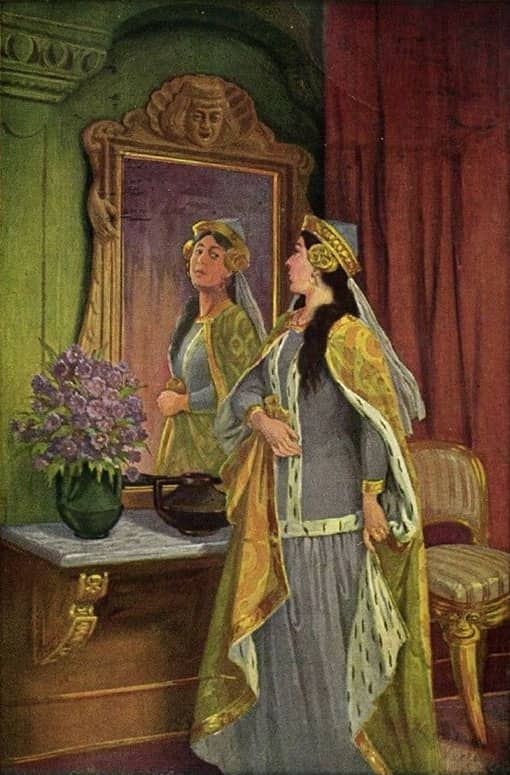 Image: Otto Kubel (1868 – 1951)
Image: Otto Kubel (1868 – 1951)Now, Snow-white was growing prettier and prettier, and when she was seven years old she was as beautiful as day, far more so than the queen herself. So one day when the queen went to her mirror and said,
„Looking-glass upon the wall,
Who is fairest of us all?“
It answered,
„Queen, you are full fair, ‚tis true,
But Snow-white fairer is than you.“
This gave the queen a great shock, and she became yellow and green with envy, and from that hour her heart turned against Snow-white, and she hated her. And envy and pride like ill weeds grew in her heart higher every day, until she had no peace day or night. At last she sent for a huntsman, and said, „Take the child out into the woods, so that I may set eyes on her no more. You must put her to death, and bring me her heart for a token.“
The huntsman consented, and led her away; but when he drew his cutlass to pierce Snow-white’s innocent heart, she began to weep, and to say, „Oh, dear huntsman, do not take my life. I will go away into the wild wood, and never come home again.“ And as she was so lovely the huntsman had pity on her, and said, „Away with you then, poor child;“ for he thought the wild animals would be sure to devour her, and it was as if a stone had been rolled away from his heart when he spared to put her to death. Just at that moment a young wild boar came running by, so he caught and killed it, and taking out its heart, he brought it to the queen for a token.
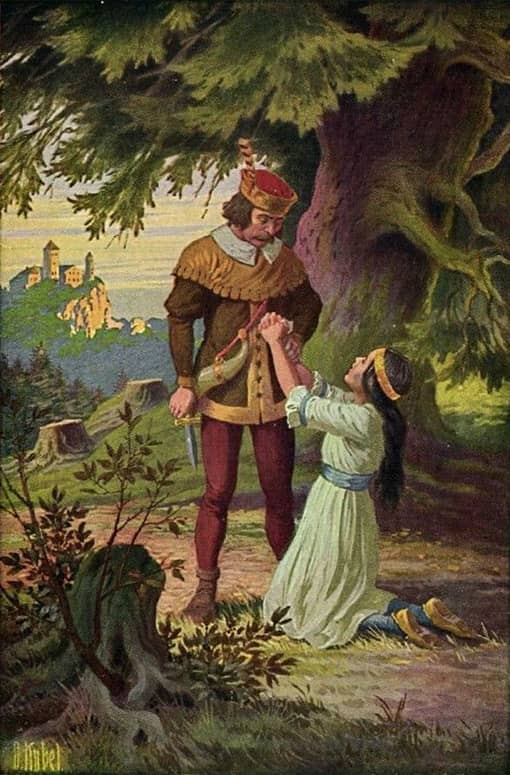 Image: Otto Kubel (1868 – 1951)
Image: Otto Kubel (1868 – 1951)And it was salted and cooked, and the wicked woman ate it up, thinking that there was an end of Snow-white. Now, when the poor child found herself quite alone in the wild woods, she felt full of terror, even of the very leaves on the trees, and she did not know what to do for fright. Then she began to run over the sharp stones and through the thorn bushes, and the wild beasts after her, but they did her no harm. She ran as long as her feet would carry her; and when the evening drew near she came to a little house, and she went inside to rest.
Everything there was very small, but as pretty and clean as possible. There stood the little table ready laid, and covered with a white cloth, and seven little plates, and seven knives and forks, and drinking-cups. By the wall stood seven little beds, side by side, covered with clean white quilts. Snow-white, being very hungry and thirsty, ate from each plate a little porridge and bread, and drank out of each little cup a drop of wine, so as not to finish up one portion alone. After that she felt so tired that she lay down on one of the beds, but it did not seem to suit her. One was too long, another too short, but at last the seventh was quite right; and so she lay down upon it, committed herself to heaven, and fell asleep.
When it was quite dark, the masters of the house came home. They were seven dwarfs, whose occupation was to dig underground among the mountains. When they had lighted their seven candles, and it was quite light in the little house, they saw that some one must have been in, as everything was not in the same order in which they left it.
The first said, „Who has been sitting in my little chair?“
The second said, „Who has been eating from my little plate?“
The third said, „Who has been taking my little loaf?“
The fourth said, „Who has been tasting my porridge?“
The fifth said, „Who has been using my little fork?“
The sixth said, „Who has been cutting with my little knife?“
The seventh said, „Who has been drinking from my little cup?“
Then the first one, looking round, saw a hollow in his bed, and cried, „Who has been lying on my bed?“ And the others came running, and cried, „Some one has been on our beds too!“ But when the seventh looked at his bed, he saw little Snow-white lying there asleep.
Then he told the others, who came running up, crying out in their astonishment, and holding up their seven little candles to throw a light upon Snow-white. „O goodness! O gracious!“ cried they, „what beautiful child is this?“ and were so full of joy to see her that they did not wake her, but let her sleep on. And the seventh dwarf slept with his comrades, an hour at a time with each, until the night had passed. When it was morning, and Snow-white awoke and saw the seven dwarfs, she was very frightened; but they seemed quite friendly, and asked her what her name was, and she told them; and then they asked how she came to be in their house.
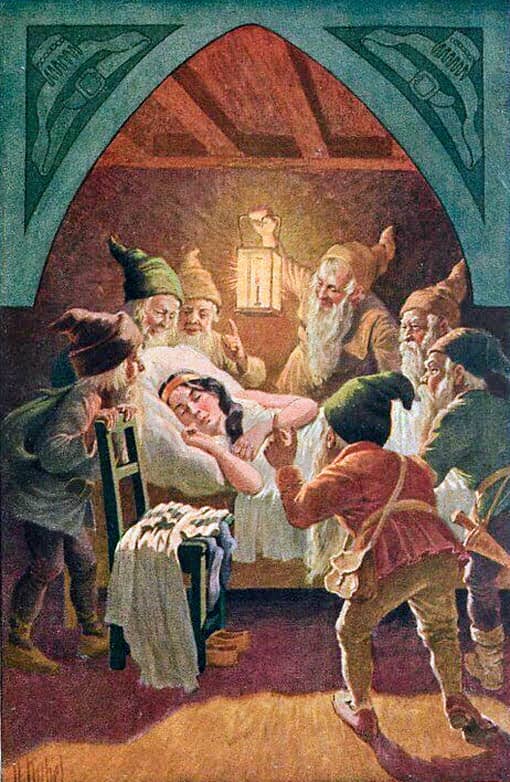 Image: Otto Kubel (1868 – 1951)
Image: Otto Kubel (1868 – 1951)And she related to them how her step-mother had wished her to be put to death, and how the huntsman had spared her life, and how she had run the whole day long, until at last she had found their little house. Then the dwarfs said, „If you will keep our house for us, and cook, and wash, and make the beds, and sew and knit, and keep everything tidy and clean, you may stay with us, and you shall lack nothing.“ – „With all my heart,“ said Snow-white; and so she stayed, and kept the house in good order.
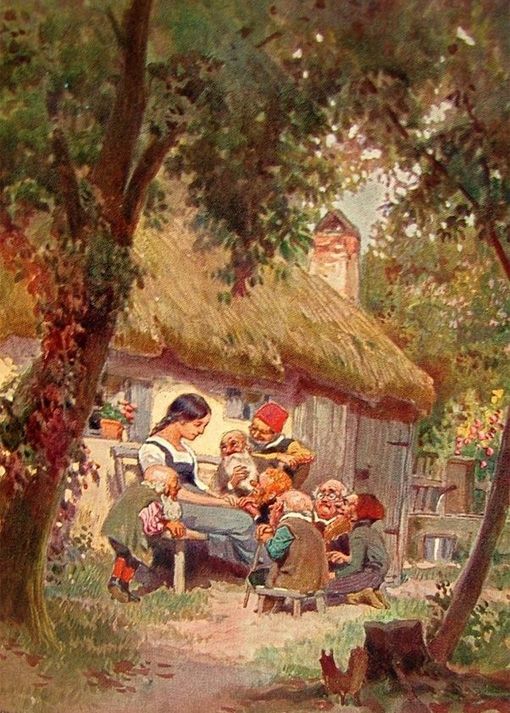 Image: Paul Hey (1867 – 1952)
Image: Paul Hey (1867 – 1952)In the morning the dwarfs went to the mountain to dig for gold. In the evening they came home, and their supper had to be ready for them. All the day long the maiden was left alone, and the good little dwarfs warned her, saying, „Beware of your step-mother, she will soon know you are here. Let no one into the house.“ Now the queen, having eaten Snow-white’s heart, as she supposed, felt quite sure that now she was the first and fairest, and so she came to her mirror, and said,
„Looking-glass upon the wall,
Who is fairest of us all?“
And the glass answered,
„Queen, thou art of beauty rare,
But Snow-white living in the glen
With the seven little men
Is a thousand times more fair.“
Then she was very angry, for the glass always spoke the truth, and she knew that the huntsman must have deceived her, and that Snow-white must still be living. And she thought and thought how she could manage to make an end of her, for as long as she was not the fairest in the land, envy left her no rest. At last she thought of a plan. She painted her face and dressed herself like an old pedlar woman, so that no one would have known her. In this disguise she went across the seven mountains, until she came to the house of the seven little dwarfs, and she knocked at the door and cried, „Fine wares to sell! fine wares to sell!“ Snow-white peeped out of the window and cried, „Good-day, good woman, what have you to sell?“
„Good wares, fine wares,“ answered she, „laces of all colours;“and she held up a piece that was woven of variegated silk. „I need not be afraid of letting in this good woman,“ thought Snow-white, and she unbarred the door and bought the pretty lace. „What a figure you are, child!“ said the old woman, „come and let me lace you properly for once.“ Snow-white, suspecting nothing, stood up before her, and let her lace her with the new lace; but the old woman laced so quick and tight that it took Snow-white’s breath away, and she fell down as dead. „Now you have done with being the fairest,“ said the old woman as she hastened away.
Not long after that, towards evening, the seven dwarfs came home, and were terrified to see their dear Snow-white lying on the ground, without life or motion. They raised her up, and when they saw how tightly she was laced they cut the lace in two. Then she began to draw breath, and little by little she returned to life. When the dwarfs heard what had happened they said, „The old pedlar woman was no other than the wicked queen. You must beware of letting any one in when we are not here!“ And when the wicked woman got home she went to her glass and said,
„Looking-glass against the wall,
Who is fairest of us all?“
And it answered as before,
„Queen, thou art of beauty rare,
But Snow-white living in the glen
With the seven little men
Is a thousand times more fair.“
When she heard that she was so struck with surprise that all the blood left her heart, for she knew that Snow-white must still be living. „But now,“ said she, „I will think of something that will be her ruin.“ And by witchcraft she made a poisoned comb. Then she dressed herself up to look like another different sort of old woman. So she went across the seven mountains and came to the house of the seven dwarfs, and knocked at the door and cried, „Good wares to sell! good wares to sell!“ Snow-white looked out and said, „Go away, I must not let anybody in.“
„But you are not forbidden to look,“ said the old woman, taking out the poisoned comb and holding it up. It pleased the poor child so much that she was tempted to open the door; and when the bargain was made the old woman said, „Now, for once your hair shall be properly combed.“ Poor Snow-white, thinking no harm, let the old woman do as she would, but no sooner was the comb put in her hair than the poison began to work, and the poor girl fell down senseless. „Now, you paragon of beauty,“ said the wicked woman, „this is the end of you,“ and went off.
By good luck it was now near evening, and the seven little dwarfs came home. When they saw Snow-white lying on the ground as dead, they thought directly that it was the step-mother’s doing, and looked about, found the poisoned comb, and no sooner had they drawn it out of her hair than Snow-white came to herself, and related all that had passed. Then they warned her once more to be on her guard, and never again to let any one in at the door. And the queen went home and stood before the looking-glass and said,
„Looking-glass against the wall,
Who is fairest of us all?“
And the looking-glass answered as before,
„Queen, thou art of beauty rare,
But Snow-white living in the glen
With the seven little men
Is a thousand times more fair.“
When she heard the looking-glass speak thus she trembled and shook with anger. „Snow-white shall die,“ cried she, „though it should cost me my own life!“ And then she went to a secret lonely chamber, where no one was likely to come, and there she made a poisonous apple. It was beautiful to look upon, being white with red cheeks, so that any one who should see it must long for it, but whoever ate even a little bit of it must die. When the apple was ready she painted her face and clothed herself like a peasant woman, and went across the seven mountains to where the seven dwarfs lived.
And when she knocked at the door Snow-white put her head out of the window and said, „I dare not let anybody in. The seven dwarfs told me not.“ – „All right,“ answered the woman; „I can easily get rid of my apples elsewhere. There, I will give you one.“ – „No,“ answered Snow-white, „I dare not take anything.“ – „Are you afraid of poison?“ said the woman, „look here, I will cut the apple in two pieces. You shall have the red side, I will have the white one.“
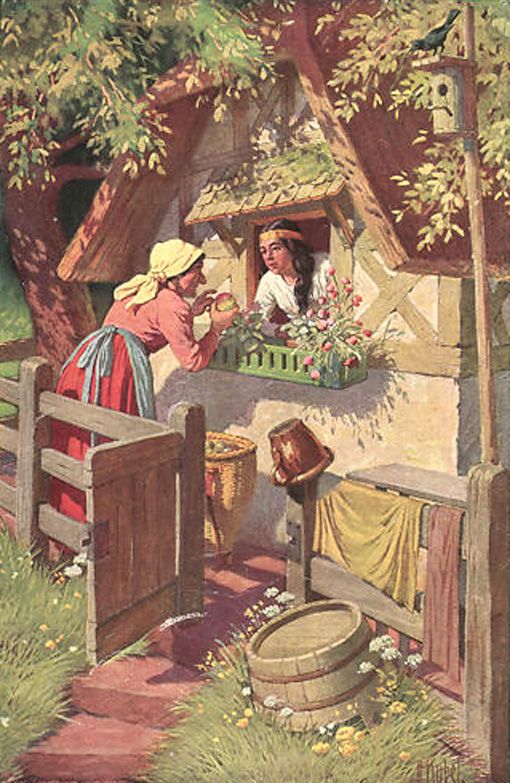 Image: Otto Kubel (1868 – 1951)
Image: Otto Kubel (1868 – 1951)For the apple was so cunningly made, that all the poison was in the rosy half of it. Snow-white longed for the beautiful apple, and as she saw the peasant woman eating a piece of it she could no longer refrain, but stretched out her hand and took the poisoned half. But no sooner had she taken a morsel of it into her mouth than she fell to the earth as dead. And the queen, casting on her a terrible glance, laughed aloud and cried, „As white as snow, as red as blood, as black as ebony! this time the dwarfs will not be able to bring you to life again.“ And when she went home and asked the looking-glass,
„Looking-glass against the wall,
Who is fairest of us all?“
at last it answered,
„You are the fairest now of all.“
Then her envious heart had peace, as much as an envious heart can have. The dwarfs, when they came home in the evening, found Snow-white lying on the ground, and there came no breath out of her mouth, and she was dead. They lifted her up, sought if anything poisonous was to be found, cut her laces, combed her hair, washed her with water and wine, but all was of no avail, the poor child was dead, and remained dead. Then they laid her on a bier, and sat all seven of them round it, and wept and lamented three whole days. And then they would have buried her, but that she looked still as if she were living, with her beautiful blooming cheeks.
So they said, „We cannot hide her away in the black ground.“ And they had made a coffin of clear glass, so as to be looked into from all sides, and they laid her in it, and wrote in golden letters upon it her name, and that she was a king’s daughter. Then they set the coffin out upon the mountain, and one of them always remained by it to watch. And the birds came too, and mourned for Snow-white, first an owl, then a raven, and lastly, a dove. Now, for a long while Snow-white lay in the coffin and never changed, but looked as if she were asleep, for she was still as‘ white as snow, as red as blood, and her hair was as black as ebony.
It happened, however, that one day a king’s son rode through the wood and up to the dwarfs‘ house, which was near it. He saw on the mountain the coffin, and beautiful Snow-white within it, and he read what was written in golden letters upon it. Then he said to the dwarfs, „Let me have the coffin, and I will give you whatever you like to ask for it.“ But the dwarfs told him that they could not part with it for all the gold in the world.
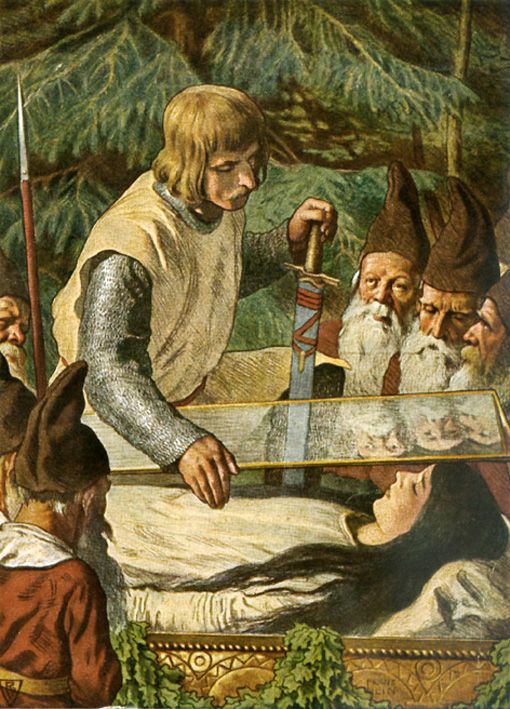 Image: Franz Hein (1863 – 1927)
Image: Franz Hein (1863 – 1927)But he said, „I beseech you to give it me, for I cannot live without looking upon Snow-white. If you consent I will bring you to great honour, and care for you as if you were my brethren.“ When he so spoke the good little dwarfs had pity upon him and gave him the coffin, and the king’s son called his servants and bid them carry it away on their shoulders. Now it happened that as they were going along they stumbled over a bush, and with the shaking the bit of poisoned apple flew out of her throat. It was not long before she opened her eyes, threw up the cover of the coffin, and sat up, alive and well. „Oh dear! where am I?“ cried she.
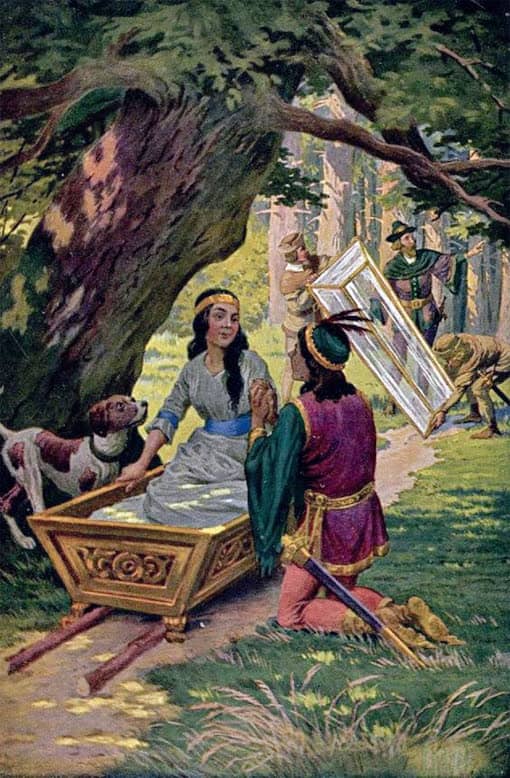 Image: Otto Kubel (1868 – 1951)
Image: Otto Kubel (1868 – 1951)The king’s son answered, full of joy, „You are near me,“ and, relating all that had happened, he said, „I would rather have you than anything in the world; come with me to my father’s castle and you shall be my bride.“ And Snow-white was kind, and went with him, and their wedding was held with pomp and great splendour. But Snow-white’s wicked step-mother was also bidden to the feast, and when she had dressed herself in beautiful clothes she went to her looking-glass and said,
„Looking-glass upon the wall,
Who is fairest of us all?“
The looking-glass answered,
“O Queen, although you are of beauty rare,
The young bride is a thousand times more fair.“
Then she railed and cursed, and was beside herself with disappointment and anger. First she thought she would not go to the wedding; but then she felt she should have no peace until she went and saw the bride. And when she saw her she knew her for Snow-white, and could not stir from the place for anger and terror. For they had ready red-hot iron shoes, in which she had to dance until she fell down dead.
 Learn languages. Double-tap on a word.Learn languages in context with Childstories.org and Deepl.com.
Learn languages. Double-tap on a word.Learn languages in context with Childstories.org and Deepl.com.Backgrounds
Interpretations
Adaptions
Summary
Linguistics
„Little Snow White“ is a well-known fairy tale collected by the Brothers Grimm in their anthology „Grimms‘ Fairy Tales“ or „Kinder- und Hausmärchen.“ The tale has its origins in the oral storytelling traditions of Germany and Europe, where various versions of the story had been passed down through generations. The Brothers Grimm, Jacob and Wilhelm, aimed to document and preserve the rich folktales and oral traditions of Germany and Europe. They gathered stories from various sources, such as friends, family, and acquaintances, and edited them to create a cohesive and readable collection. The Grimm brothers‘ version of „Little Snow White“ is the most widely recognized and has shaped subsequent retellings and adaptations of the story.
„Little Snow White“ tells the story of a young princess, Snow White, who faces the jealousy and wrath of her stepmother, an evil queen obsessed with being the fairest in the land. The queen orders a huntsman to kill Snow White, but he spares her life, and she finds refuge in the home of seven dwarfs. The queen, learning that Snow White is still alive, makes three attempts to kill her using a tight corset, a poisoned comb, and a poisoned apple. Each time, the dwarfs revive Snow White, but the third attempt leaves her in a death-like state. A prince discovers Snow White’s body and falls in love with her, and when the glass coffin is moved, the piece of poisoned apple becomes dislodged from her throat, and she awakens. The prince and Snow White marry, and the evil queen is invited to the wedding. As punishment, she is forced to dance in red-hot iron shoes until she dies.
„Snow White“ is a 19th-century German fairy tale that has become widely known across the world. It was published in 1812 in the first edition of the Brothers Grimm’s collection, Grimms‘ Fairy Tales, and was numbered as Tale 53. The story features elements such as the magic mirror, the poisoned apple, the glass coffin, the Evil Queen, and the seven dwarfs. The fairy tale has been adapted and changed over the years, with the most famous and sanitized version being the 1937 American animated film Snow White and the Seven Dwarfs by Walt Disney. This tale type is widespread in Europe, America, Africa, and some Turkic traditions. Some scholars have also found similar tale types in Central Asia, Eastern Siberia, the Middle East, China, India, and the Americas.
The background and origin of the Snow White fairy tale can be traced back to European folktales that have evolved and changed over time. While the exact origin is unclear, scholars have identified certain motifs and themes in Snow White that can be found in other tales across various cultures. The tale’s most popular version, as recorded by the Brothers Grimm in the 19th century, has a German background. The Grimm Brothers collected folktales from various sources, often making revisions and adaptations to suit their audience. In their first edition, the villain was Snow White’s biological mother, but this was later changed to a stepmother in subsequent editions.
While some theories suggest that the story of Snow White might have been inspired by real-life historical figures, such as Margaretha von Waldeck or Maria Sophia Margarethe Catharina, Baroness von und zu Erthal, these theories have been largely dismissed by serious scholars. The fairy tale also shares similarities with ancient Roman legends, such as the story of Chione, as recorded in Ovid’s Metamorphoses. The Snow White tale has many variations across different cultures, and these variations often highlight different aspects of the story or provide alternative endings. These variations, along with the tale’s widespread popularity, speak to the enduring appeal of the story and its themes.
The tale of „Little Snow White“ explores themes of jealousy, beauty, and the struggle between good and evil. The story has been adapted and reimagined countless times throughout history, with variations reflecting cultural and social changes. The Brothers Grimm’s version of the story remains the most iconic, shaping the way Snow White has been portrayed in literature, film, and other media over the years.
„Little Snow White“ is a classic fairy tale from the Brothers Grimm that has captured the imagination of audiences for generations. The story has several themes and interpretations, some of which are discussed below:
Jealousy and Vanity: The evil queen’s jealousy and obsession with her own beauty drive her to attempt to kill Snow White. This theme serves as a cautionary tale about the destructive power of jealousy and the dangers of vanity.
Innocence and Purity: Snow White is often portrayed as a symbol of innocence and purity, both in her appearance and actions. Her resilience against the evil queen’s schemes may be interpreted as a testament to the power of goodness and virtue.
The Struggle Between Good and Evil: The tale presents a clear struggle between good (Snow White) and evil (the evil queen). It highlights the importance of inner beauty and goodness, which ultimately triumph over evil.
The Power of Friendship and Compassion: Snow White’s relationship with the seven dwarfs showcases the power of friendship and compassion. They provide her with shelter and protection, and in return, she takes care of them. This theme emphasizes the value of kindness and mutual support.
The Role of Fate and Destiny: Snow White’s story unfolds in a way that suggests a larger force is at work, guiding her to safety and eventual happiness. The chance encounters with the dwarfs and the prince may be interpreted as evidence of destiny or fate at play.
The Danger of Trusting Strangers: The tale warns of the potential dangers of trusting strangers, as Snow White repeatedly falls victim to the evil queen’s disguised appearances. This theme serves as a cautionary lesson about being cautious and discerning in unfamiliar situations.
Female Empowerment and Stereotypes: Some modern interpretations of „Little Snow White“ focus on the gender dynamics in the story, critiquing the portrayal of female characters as either innocent victims or jealous villains. These interpretations may explore how the story both reinforces and challenges traditional gender roles and stereotypes.
„Little Snow White“ is a rich and enduring tale that offers multiple interpretations and insights, providing readers and listeners with a variety of themes and lessons to ponder. The story’s continued popularity and relevance can be attributed to its timeless themes and universal appeal.
„Little Snow White“ has been widely adapted in various forms of media over the years. Some notable adaptations and reinterpretations include.
Animated Films: Disney’s Snow White and the Seven Dwarfs (1937): One of the most famous adaptations of the tale, this animated film by Walt Disney is a classic that has shaped the popular image of Snow White. The film introduces the seven dwarfs with their unique names and personalities and features memorable songs like „Whistle While You Work“ and „Heigh-Ho.“ This classic Disney animated film is perhaps the most well-known adaptation of the story. It introduced the characters of Doc, Grumpy, Happy, Sleepy, Bashful, Sneezy, and Dopey, and made Snow White a household name. Snow White with the Red Hair (2015) – This anime series reimagines the story in a medieval fantasy setting. It follows the adventures of Shirayuki, a young herbalist with unusual red hair, who is pursued by the prince of her kingdom.
Films: Mirror Mirror (2012): A comedic and light-hearted adaptation, this film stars Lily Collins as Snow White and Julia Roberts as the evil queen. It offers a fresh and modern take on the story, with a stronger and more independent Snow White character. The film was notable for its whimsical costumes and colorful visuals. Snow White and the Huntsman (2012): An action-packed adaptation that stars Kristen Stewart as Snow White, Charlize Theron as the evil queen, and Chris Hemsworth as the huntsman. The film presents a more empowered Snow White, who leads an army to reclaim her kingdom. Snow White: A Tale of Terror (1997): A dark and Gothic retelling of the story, this film stars Sigourney Weaver as the evil queen and Monica Keena as Snow White. It explores a more sinister and complex relationship between the stepmother and stepdaughter and delves into darker themes. Grimm’s Snow White (2012) – This low-budget indie film stars Jane March as the queen and Eliza Bennett as Snow White. It was notable for its dark, gritty tone and unconventional storytelling.
Literature: Various retellings and reinterpretations of „Little Snow White“ have been published, including books like „Snow White“ by Donald Barthelme, „Fairest“ by Gail Carson Levine, and „Snow White and the 77 Dwarfs“ by Davide Cali.
TV: Once Upon a Time (2011-2018): A TV series that weaves together various fairy tales, including Snow White. The show features Ginnifer Goodwin as Snow White/Mary Margaret Blanchard and Lana Parrilla as the evil queen/Regina Mills. It provides a more complex and nuanced portrayal of the characters and their relationships. Snow White: The Fairest of Them All (2001) – This made-for-TV movie starred Kristin Kreuk as Snow White and Miranda Richardson as the queen. The film was praised for its faithful adaptation of the original story and strong performances.
Stage productions: Snow White has been adapted into numerous stage productions, including ballets, operas, plays, and musicals. Some examples are „Snow White and the Seven Dwarfs“ by Jan McArt, the ballet „Schneewittchen“ choreographed by Heinz Spoerli, and the opera „Blancanieves“ by Emilio Aragón.
These adaptations showcase the enduring appeal and versatility of the „Little Snow White“ fairy tale, allowing it to be reimagined and retold in various ways, while still retaining its core themes and messages. These are just a few examples of the many adaptations of „Little Snow White“ that have been created over the years.
„Little Snow White“ is a classic fairy tale collected by the Brothers Grimm that tells the story of a beautiful young princess named Snow White and her struggle against her jealous stepmother, the evil queen.
The tale begins with a queen who wishes for a child with skin as white as snow, lips as red as blood, and hair as black as ebony. Her wish comes true, but she dies during childbirth, leaving her daughter, Snow White, and her husband behind. The king remarries, and his new wife is a vain and wicked woman who possesses a magical mirror. The mirror always tells her that she is the fairest in the land, but as Snow White grows older, her beauty surpasses that of the queen. One day, the mirror tells the queen that Snow White is now the fairest.
Furious with jealousy, the evil queen orders a huntsman to take Snow White into the forest and kill her. However, the huntsman cannot bring himself to kill the innocent girl and instead tells her to run away and never return. Snow White finds a small cottage in the woods, inhabited by seven dwarfs. They take her in, and she takes care of them in return.
The evil queen, believing Snow White to be dead, asks her mirror once again who the fairest is, only to find out that Snow White is still alive. The queen then decides to take matters into her own hands and makes three attempts on Snow White’s life, disguising herself each time. First, she tries to suffocate Snow White with a tight corset, then she attempts to kill her with a poisoned comb, and finally, she succeeds in putting Snow White into a death-like state with a poisoned apple.
The dwarfs, thinking Snow White is dead, place her in a glass coffin. One day, a prince traveling through the forest comes upon the coffin and falls in love with Snow White. He convinces the dwarfs to let him take the coffin with him. As his servants carry the coffin, they stumble, causing the piece of poisoned apple to dislodge from Snow White’s throat, and she awakens.
Snow White and the prince marry, and they invite the evil queen to their wedding. As punishment for her wickedness, the queen is forced to dance in red-hot iron shoes until she dies. Snow White and the prince live happily ever after, illustrating the ultimate triumph of good over evil.
Conducting a linguistic analysis of the Brothers Grimm’s version of „Little Snow White“ involves examining various elements such as lexical choices, syntax, stylistic features, and underlying themes conveyed through language.
Here’s an analysis focusing on different linguistic aspects:
Lexical Choices
Descriptive Adjectives: The use of vivid adjectives like „white as snow,“ „red as blood,“ „black as ebony,“ „beautiful,“ „proud,“ „overbearing,“ „yellow and green with envy“ create stark visual images and emphasize the story’s contrast between beauty and evil. Nature imagery is prevalent, with words like „snow-flakes,“ „wild wood,“ „sharp stones,“ „thorn bushes,“ enhancing the fairy-tale’s mystical and naturalistic elements.
Repetition: Phrases like „looking-glass upon the wall,“ „who is fairest of us all?“ and the repeated answers of the mirror demonstrate the importance of beauty and truth in the story. The repetition of Snow White’s beauty description enforces her purity and innocence.
Names and Titles: The choice of the name „Snow-white“ itself is symbolic, contrasting her innocence with the stepmother’s malicious intentions.
Syntax
Simple Sentence Structure: The syntax often features simple sentences and coordinating conjunctions, typical of oral storytelling traditions, which make the story accessible to a younger audience. For example, „The huntsman consented, and led her away“ uses simple, direct language that moves the narrative swiftly forward.
Direct Speech: The frequent use of direct speech enlivens the narrative and characterizes relationships, as seen in dialogues between the queen and her mirror, and between Snow White and her stepmother.
Stylistic Features
Fairy Tale Conventions: The narrative follows a linear progression from problem to resolution, typical of fairy tales. Magical and fantastical elements like the „magic looking-glass“ and the dwarfs living in a cottage create an enchanted atmosphere.
Moral Dichotomy: The good-versus-evil theme is conveyed through a strong moral dichotomy. The good characters (Snow White and the dwarfs) are placed in direct contrast to the evil stepmother, whose dark actions and envy are portrayed as villainous.
Symbolism and Metaphors: Elements like the „poisoned apple“ symbolize deceit and the dangers of vanity and envy. Color symbolism (white, red, black) is pervasive, signifying purity, life, and mortality.
Underlying Themes
Beauty and Envy: The linguistic focus on beauty highlights its paramount importance in the story’s world, driving the stepmother’s envy and subsequent actions.
Innocence versus Malice: Snow White’s innocence is linguistically juxtaposed with the queen’s malice, highlighted through semantic fields of purity versus deceit.
Transformation and Resilience: Language around life, death, and rebirth speaks to transformation, as Snow White’s ‚deaths‘ and awakenings illustrate resilience and eventual triumph over adversity.
Conclusion
The linguistic features of the Brothers Grimm’s „Little Snow White“ contribute significantly to the creation of its iconic fairy-tale world. Descriptive language, repetition, and simple syntax help convey traditional themes of beauty, envy, and the struggle between good and evil. The tale’s universality and enduring appeal are reinforced through its vivid imagery and moral clarity, rendered effectively through its language.
Information for scientific analysis
Fairy tale statistics | Value |
|---|---|
| Number | KHM 53 |
| Aarne-Thompson-Uther-Index | ATU Typ 709 |
| Translations | DE, EN, EL, DA, ES, FR, PT, FI, HU, IT, JA, NL, PL, RO, RU, TR, VI, ZH |
| Readability Index by Björnsson | 29.6 |
| Flesch-Reading-Ease Index | 82.8 |
| Flesch–Kincaid Grade-Level | 7 |
| Gunning Fog Index | 9.5 |
| Coleman–Liau Index | 7.3 |
| SMOG Index | 7.3 |
| Automated Readability Index | 7.7 |
| Character Count | 16.008 |
| Letter Count | 12.173 |
| Sentence Count | 145 |
| Word Count | 3.106 |
| Average Words per Sentence | 21,42 |
| Words with more than 6 letters | 255 |
| Percentage of long words | 8.2% |
| Number of Syllables | 3.754 |
| Average Syllables per Word | 1,21 |
| Words with three Syllables | 71 |
| Percentage Words with three Syllables | 2.3% |
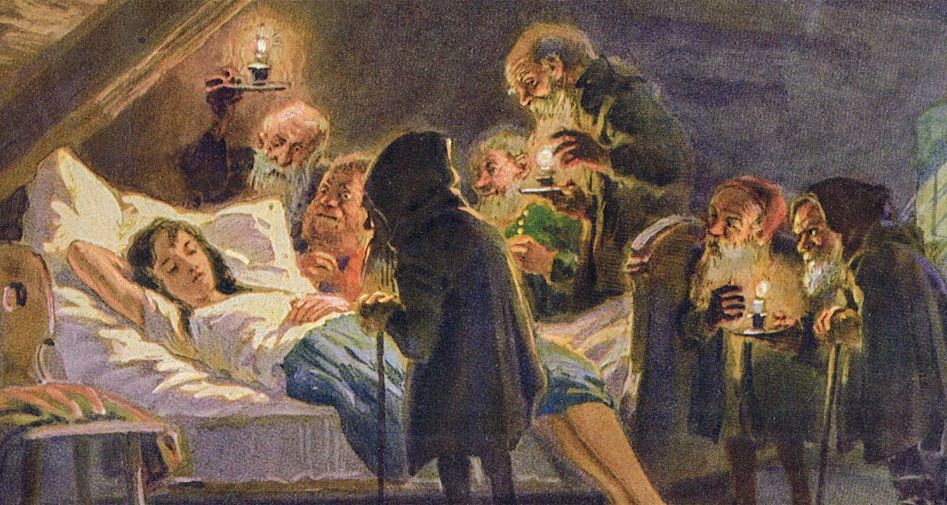
 Facebook
Facebook  Whatsapp
Whatsapp  Messenger
Messenger  Telegram
Telegram Reddit
Reddit














